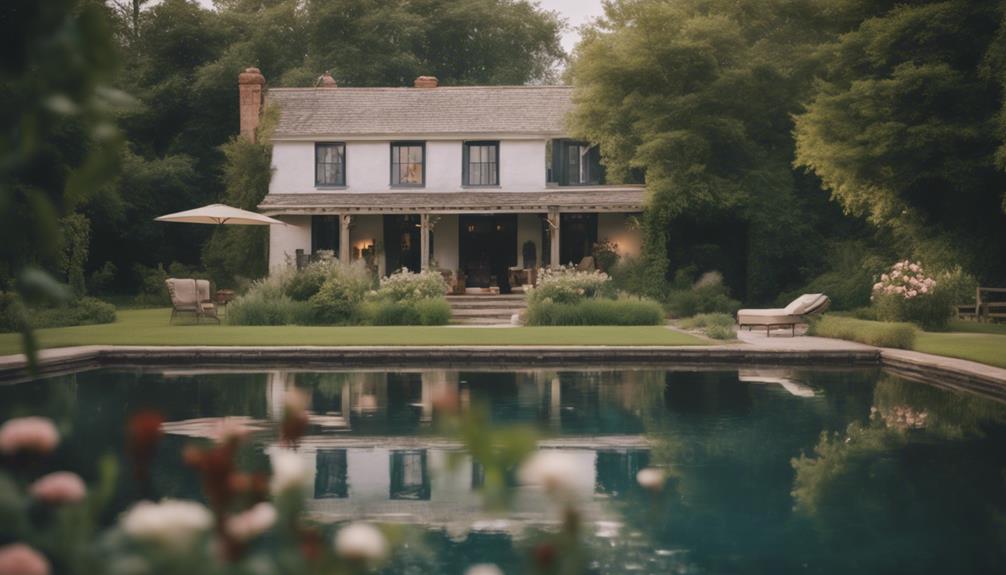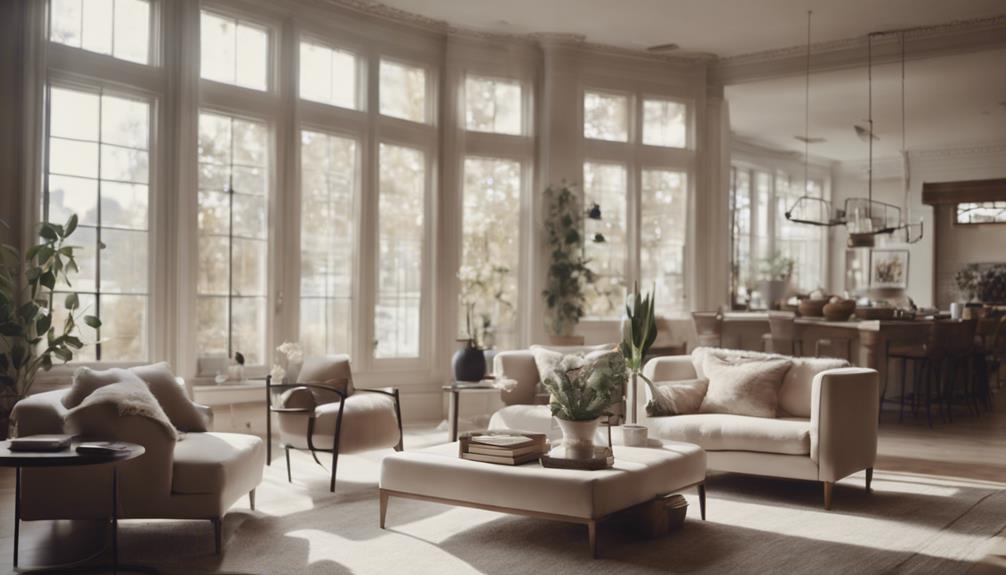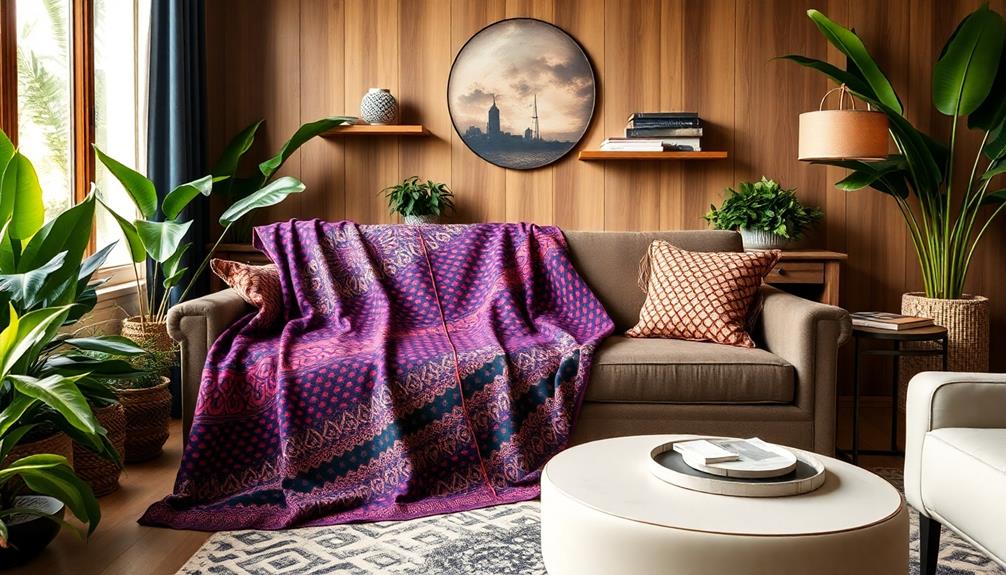Soho Farmhouse is the perfect luxurious retreat in the Cotswolds, located just under two hours from London. This 100-acre estate features charming cabins and unique glamping accommodations, all enhanced by modern amenities. Guests can select from a range of dining options, including hearty British fare and Japanese-inspired dishes. Relaxation awaits at the Cowshed Spa and infinity pool, while activities like clay pigeon shooting and horseback riding offer entertainment. With exclusive membership opportunities, guests can enjoy a vibrant community atmosphere. There is a wealth of experiences waiting to be discovered, and the next section will uncover what makes this getaway truly exceptional.
Key Takeaways
- Nestled in the Cotswolds, Soho Farmhouse offers a blend of countryside charm and modern luxury across 100 acres of stunning scenery.
- Accommodation options include rustic cabins, a spacious Farm Cottage, and glamping experiences, all equipped with luxurious amenities.
- Dining features diverse options, from traditional British dishes to Japanese-inspired cuisine, emphasizing seasonal and sustainable ingredients.
- The Cowshed Spa provides rejuvenating treatments, and wellness facilities include a heated infinity pool and a health club for fitness enthusiasts.
Location and Ambiance
Nestled in the picturesque Cotswolds, Soho Farmhouse offers a serene escape just under two hours from London, blending countryside charm with modern luxury. Set within 100 acres of the stunning Oxfordshire countryside, this members club serves as the perfect tranquil retreat for anyone looking to unwind from the fast pace of urban life.
Upon arrival, you'll be greeted by charming farmhand transportation, whisking you through the idyllic surroundings of the estate, setting the tone for a relaxing getaway. The atmosphere here strikes a perfect balance; weekends pulse with energy, drawing a lively crowd reminiscent of city nightlife, while weekdays invite a more laid-back vibe.
As you explore, you'll discover rustic cabins and unique glamping options that reflect the natural beauty of the area while offering luxurious amenities like infinity pools and spa facilities. Whether you're seeking adventure or simply a place to recharge, Soho Farmhouse has something for everyone.
Its stunning setting and vibrant ambiance make it a standout choice for a luxurious getaway, inviting you to escape the ordinary and embrace the extraordinary.
Accommodation Choices

Soho Farmhouse boasts 40 rustic cabins, each designed with luxurious amenities that guarantee a comfortable and memorable stay. From wood-burning stoves to rainforest showers, these cabins blend charm and comfort perfectly. If you're traveling with family or a larger group, the spacious Farm Cottage offers four bedrooms, providing ample space for everyone to unwind.
For those seeking a unique adventure, glamping experiences await you in beautifully designed bell tents. These tents allow you to connect with nature while enjoying the comforts you crave. Picture yourself soaking in an outdoor bathtub, surrounded by serene countryside views—it's a one-of-a-kind experience you won't forget.
| Accommodation Type | Features |
|---|---|
| Rustic Cabins | Wood-burning stoves, floor-to-ceiling windows |
| Spacious Farm Cottage | Four bedrooms, ideal for families |
| Glamping Experiences | Bell tents, adventure with comfort |
| Select Cabins | Outdoor bathtubs, nature views |
| New Hideaways | Smaller cabins opening in December |
With varied options like these, you'll find the perfect luxury accommodations at Soho Farmhouse to create lasting memories.
Dining Options

At Soho Farmhouse, you'll find a diverse array of dining options that cater to every palate, ensuring memorable meals during your stay.
The Main Barn serves as the central dining venue, offering an all-day menu filled with delicious British dishes, especially the renowned Sunday roast that you won't want to miss.
If you're in the mood for something different, head over to Pen Yen, where you can indulge in Japanese-inspired cuisine featuring sushi, bao buns, and succulent black cod.
For a more casual dining experience, the Hay Barn is perfect for relaxed meals with family and friends, showcasing delightful wood-fired pizzas and pastas.
If you're looking for late-night bites, the Mill Room operates as a cozy country pub, providing a warm atmosphere for drinks and casual dining.
To start your day right, don't forget to check out the breakfast truck, which conveniently delivers fresh breakfast options right on-site.
Each dining venue at Soho Farmhouse not only offers unique flavors but also enhances your overall dining experience with its inviting ambiance and exceptional service.
Spa and Wellness Facilities

At Soho Farmhouse, you can indulge in rejuvenating treatments at the Cowshed Spa, where every massage and facial is designed to enhance your relaxation.
After your spa experience, take a revitalizing swim in the infinity pool, offering stunning views that make every stroke feel special.
If you're keen on staying active, the health club provides a variety of fitness options to keep your wellness routine on track.
Cowshed Spa Treatments
The Cowshed Spa offers a range of rejuvenating treatments, including massages and facials, all designed to enhance your wellness experience. You'll find a selection of signature services that utilize cheeky products aimed at promoting relaxation and rejuvenation. Whether you opt for a soothing CBD massage or a revitalizing facial, each treatment is tailored to meet your unique needs.
The spa's serene environment is complemented by wooden hot tubs and tranquil relaxation areas, inviting you to unwind fully. As you indulge in your chosen treatments, you'll appreciate the holistic approach that guarantees both physical and mental rejuvenation. It's about more than just pampering; it's about creating a space where you can truly escape the everyday.
While you're there, don't forget to take advantage of the amenities, including the stunning infinity pool. This space not only enhances your spa experience but also offers picturesque views of the surrounding countryside, adding to your sense of tranquility.
At the Cowshed Spa, every detail is meticulously crafted to provide you with the ultimate relaxation and wellness journey, making it a must-visit during your stay at Soho Farmhouse.
Infinity Pool Experience
Plunge into the unforgettable infinity pool experience at Soho Farmhouse, where stunning countryside views await you as you swim and relax. Open daily from 6:30 am to 10 pm, the infinity pool combines the best of both worlds with its indoor-outdoor access, allowing you to immerse yourself in nature while enjoying the luxurious ambiance.
The pool area is designed for rejuvenation, featuring wooden hot tubs and ample relaxation spaces that invite you to unwind after a day of exploration. As part of the wellness offerings, you have full access to the infinity pool, which enhances your stay alongside an array of spa treatments available at the renowned Cowshed Spa.
Families can rest easy knowing that the infinity pool accommodates everyone, with designated children swimming hours ensuring a safe and enjoyable experience for younger guests. Whether you're looking to soak in the serene surroundings or simply enjoy some quality family time, the infinity pool at Soho Farmhouse promises an exceptional escape that rejuvenates your body and spirit.
Wellness and Fitness Activities
Soho Farmhouse offers a holistic wellness experience that combines rejuvenating spa treatments with invigorating fitness activities to help you unwind and stay active during your stay.
At the Cowshed Spa, indulge in a variety of treatments, including soothing massages and revitalizing facials, all designed to promote relaxation and rejuvenation.
You can take a dip in the stunning indoor-outdoor heated infinity pool, open daily from 6:30 am to 10 pm, providing a picturesque swimming experience in the countryside. The spa facilities also feature wooden hot tubs and cozy relaxation areas, enhancing your luxurious wellness experience.
If you're looking to stay active, the health club has everything you need. Join group fitness classes tailored to different levels, or utilize free weights and Peloton bikes for a personalized workout.
Plus, families will appreciate that children have access to the indoor-outdoor pool for two hours on weekdays and weekends, ensuring everyone can enjoy wellness activities together.
Activities and Recreation

Offering a variety of engaging activities, guests can immerse themselves in everything from clay pigeon shooting to relaxing treatments at the Cowshed Spa. At Soho Farmhouse, you'll find plenty of outdoor activities to keep you entertained.
Take a scenic horseback riding trip or challenge your friends to a round of nine-hole crazy golf against the stunning countryside backdrop. If swimming's more your style, enjoy the indoor-outdoor heated pool, open daily from 6:30 am to 10 pm. It's the perfect spot to unwind after a day of exploring.
For those seeking relaxation, the Cowshed Spa provides an array of treatments and outdoor wooden hot tubs, ensuring you leave feeling rejuvenated.
When the sun sets, gather your friends or family for a movie night at the Electric Barn cinema, where you can catch both new releases and classic films. If you're keen to stay active, join a group fitness class at the health club, equipped with free weights and Peloton bikes.
Whether you're looking for adventure or relaxation, Soho Farmhouse has something for everyone, making your getaway truly unforgettable.
Sustainability Initiatives
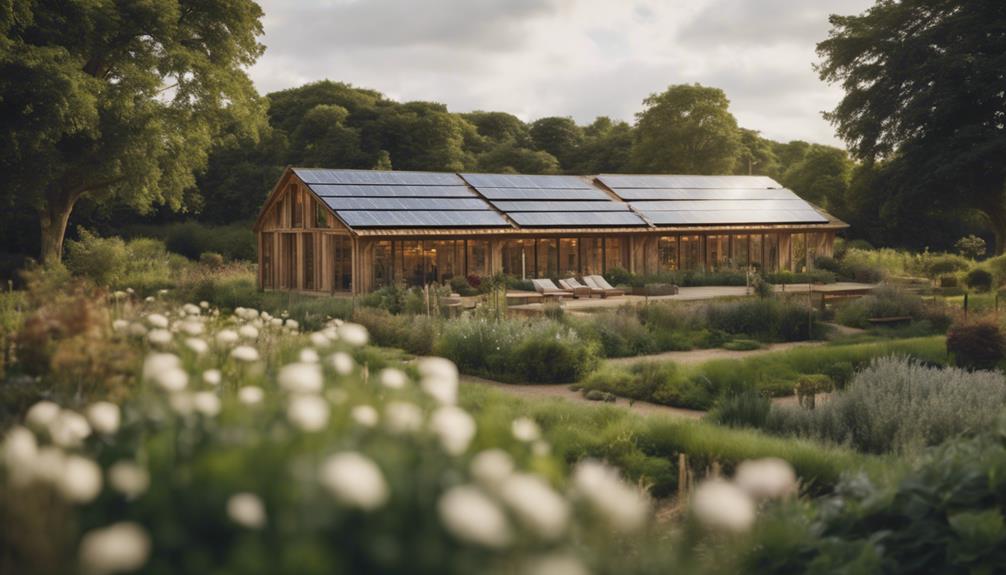
At Soho Farmhouse, you're stepping into a world where sustainability is a priority. Their environmental impact strategy focuses on responsible sourcing and reducing waste, so you can enjoy your stay while knowing it's eco-conscious.
You'll find that every meal not only delights your palate but also supports ethical practices and a smaller carbon footprint.
Environmental Impact Strategy
Committed to an ambitious environmental impact strategy, the Farmhouse focuses on sustainability and aims to considerably reduce its carbon footprint by 2030.
You'll notice that Soho Farmhouse enhances its recycling programs and implements responsible food waste management practices. This commitment not only minimizes environmental impact but also sets a standard for luxury venues.
When dining, you can enjoy a diverse menu that emphasizes meat-free dishes and seasonal ingredients. This approach promotes sustainable eating practices, making it easy for you to indulge while being eco-conscious.
The Farmhouse continuously evaluates its carbon emissions, ensuring that strategies for reduction are at the forefront of its operations.
Sustainable Sourcing Practices
Soho Farmhouse prioritizes sustainable sourcing by guaranteeing that its coffee, cocoa, and palm oil come from responsibly managed suppliers.
You'll find that their commitment to sustainable practices extends beyond sourcing; they focus on reducing their carbon footprint through thoughtful menu design. With an emphasis on meat-free dishes and seasonal ingredients, the venue promotes local produce, which not only supports nearby farmers but also enhances the freshness of your dining experience.
In addition to food sourcing, Soho Farmhouse actively integrates environmental sustainability into its operations. They've set ambitious sustainability goals for 2030, including enhancing recycling programs and improving food waste management.
By continuously evaluating their carbon footprint, they implement measures to minimize emissions, making your stay even more eco-friendly.
When you choose to dine or stay at Soho Farmhouse, you're embracing a lifestyle that values responsible consumption and environmental care. This commitment to sustainable sourcing practices guarantees that your luxurious getaway doesn't compromise the planet's health.
You can relax knowing that every cup of coffee and every meal is a step towards a greener future.
Pricing and Booking Details
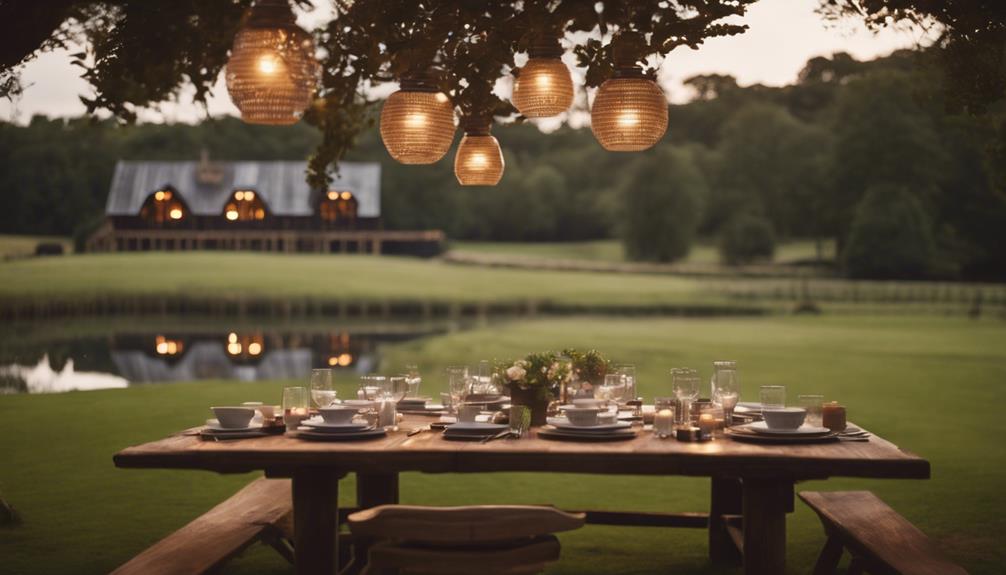
Rates for accommodations typically start at GBP695.00 for the cheapest double room available within the next 60 days, inclusive of taxes and fees. At Soho Farmhouse, booking in advance is essential, as the retreat enjoys a high occupancy rate of 98.7% throughout the year.
Here's what you need to know about pricing and booking:
- Exclusive Access: Non-members must submit a reservation form to secure their stay, emphasizing the exclusive nature of this getaway.
- Flexibility in Dining: Breakfast isn't included in the room rates, allowing you to explore various dining options on-site.
- Payment Considerations: If you're an international guest, check current exchange rates, as they may impact your final cost.
To guarantee you get the best accommodations and activities, make your booking as soon as possible.
Whether you're planning a romantic retreat or a weekend with friends, Soho Farmhouse offers a unique experience that's worth the investment.
Enjoy the luxurious comforts and scenic surroundings while indulging in the exclusivity that only this destination can provide.
Transportation and Accessibility

Getting to Soho Farmhouse is easy, thanks to a variety of transportation options available for guests.
If you're arriving by train, the closest stop is Banbury station, where you can catch direct trains from London Paddington or Marylebone, taking about 1.5 hours. Once you reach Banbury, a quick 35-minute taxi ride will have you at the farmhouse.
If you prefer driving, expect around a 2-hour journey from central London, and you'll find ample free parking on-site.
For a more personalized experience, consider booking private car transfers, which are available upon request. If you're flying into London Heathrow Airport, the drive to Soho Farmhouse is roughly 1.5 hours.
If you want to skip the road altogether, there's even a helipad for quicker access, although you'll need to notify the staff in advance.
Additionally, private driver services from nearby train stations are an option, typically costing around 80 Euros. Taxis can also be arranged for local dining, ensuring you have everything you need for a seamless getaway.
Exclusive Membership Experience

To enjoy the unique offerings of this exclusive retreat, you'll need to secure a Soho House or Soho Friends membership for your stay. This private members' experience at Soho Farmhouse is designed for those who appreciate luxury in a country retreat setting. With a high occupancy rate of 98.7%, it's clear that this luxury boutique is a favorite among affluent guests, including celebrities.
As an exclusive member, you can enhance your stay by:
- Bringing Guests: You can invite up to three guests for overnight visits, allowing you to share the experience with friends or family.
- Day Visits: Members can enjoy day visits, but remember that access to amenities like the gym is restricted during these times.
- Casual Atmosphere: Embrace the relaxed dress code and house rules that foster a vibrant community feel, making your experience even more enjoyable.
Frequently Asked Questions
Can You Stay at Soho Farmhouse as a Non-Member?
Yes, you can stay at Soho Farmhouse as a non-member by submitting a reservation form. However, priority's given to members, so booking in advance is essential due to high demand and limited availability.
What Celebs Go to Soho Farmhouse?
Like moths to a flame, celebrities flock to Soho Farmhouse. You'll spot stars from film, music, and fashion mingling effortlessly, drawn by its exclusivity, rustic charm, and the chance for a private escape.
What Style Is Soho Farmhouse?
You'll find a rustic yet luxurious style at Soho Farmhouse, blending distressed decor with modern comforts. Its design features natural materials, cozy furnishings, and a chic atmosphere, creating a perfect retreat for relaxation and sophistication.
How Much Is Soho House Farmhouse?
If you're wondering how much Soho House Farmhouse costs, rates for a double room start at GBP 695. Breakfast isn't included, and it's wise to book early due to high occupancy rates.
Is Soho Farmhouse Suitable for Family Getaways?
Soho Farmhouse is perfect for family getaways with its array of activities for all ages. While parents can relax at the spa, kids can enjoy the outdoor play areas. The mama’s farmhouse dining experience offers a cozy and family-friendly atmosphere, making it an ideal choice for a family retreat.
What Makes Soho Farmhouse a Luxurious Option for Getaway?
Soho Farmhouse offers a luxurious getaway with a unique twist – the family dining experience at mama’s farmhouse. This exclusive feature allows guests to enjoy delicious meals in a cozy and welcoming setting, creating unforgettable memories with loved ones. It’s the perfect blend of luxury and warmth for a remarkable retreat.
Conclusion
Soho Farmhouse isn't just a place to stay; it's a delightful escape that wraps you in comfort and tranquility.
With charming accommodations, exquisite dining, and rejuvenating spa treatments, you're bound to leave your worries behind.
Embrace the lush surroundings and indulge in unique activities that ignite your spirit.
Whether you're seeking a weekend retreat or a longer getaway, this luxurious haven invites you to unwind and savor every moment of your enchanting experience.
